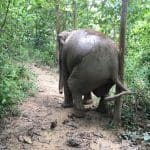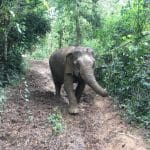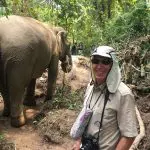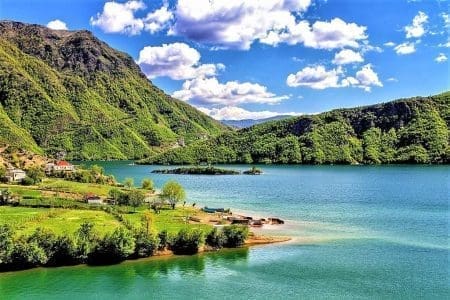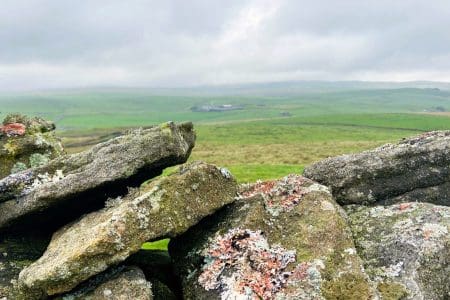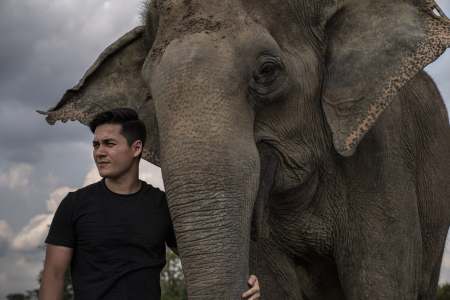On his recent visit to northern Laos, Mark Bibby Jackson visits Mandalao Elephant Sanctuary near Luang Prabang to discover more about the ethical ways that tourists can interact with elephants and goes walking with elephants.
On the side of the road a man is sitting on an elephant inviting people to go on rides. Nearby a tiger, presumably drugged to pacify him, sits placidly on the pavement waiting for people to stroke him, his guardian by his side. The scene is in Thailand close to Pattaya, in a dinosaur park aimed at children. Yet, it could well be set in many tourist attractions across the Southeast Asian region. Fortunately, increasingly such exploitation of animals in the tourism sector – at least for western tourism – is becoming something of the past.
Like a born-again smoker who has replaced his 20 Marlborough a day with a diet of mindfulness and yoga, I now adopt a strict non-riding approach
To Ride or Not To Ride
A key issue facing responsible tourists in Laos, as in other countries such as Thailand and Sri Lanka, is whether you should ride elephants.
Like a born-again smoker who has replaced his 20 Marlborough a day with a diet of mindfulness and yoga, I now adopt a strict non-riding approach.
Having once ridden an elephant in northwest Thailand, albeit bareback – the elephant not myself – and in a sanctuary, I was converted on the road to the Mondulkiri Project elephant sanctuary in northeast Cambodia. There visitors can walk with elephants washing them in the stream that runs through the sanctuary property. I was informed how the animals are badly maltreated as domestic animals, particularly in the logging industry.
While on my tuk tuk journey around northwest Thailand, I had stopped at the Maevang Elephant Home, a place where tourists used to ride elephants, but that has, like me, been converted. There, we followed the elephants down to the river, and as at the Mondulkiri Project we washed them behind their ears.
To Wash or Not To Wash
For some even this controlled interaction between tourist and elephant is a step too far.
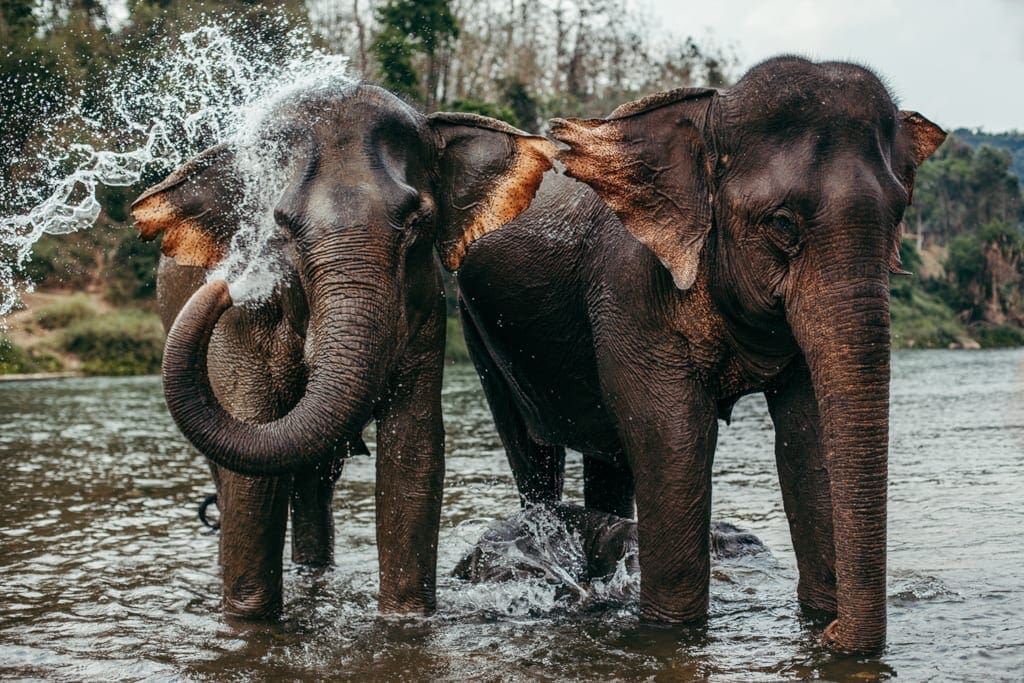
Coinciding with World Elephant Day on 12 August, 2018, the NGO World Animal Protection (WAP) produced a guide for what to look out for when booking a trip to an elephant sanctuary. It highlighted avoiding rides or shows, observing clear signs of cruelty, such as an elephant being chained, and to select venues that keep the interaction to a minimum with humans observing elephants from a distance.
In an ensuing dialogue concerning whether tourists should bathe with elephants, Kimi Gill, WAP UK Communications and Media Officer, outlined why the organisation disapproves of this interaction.
“The elephants involved in washing activities might be forced into participating for the benefit of the tourists paying for the experience,” she informed me, adding that “being closely surrounded by people they don’t know is inherently quite stressful for elephants and in most cases, mahouts are required to keep them under control at all times, often through the use or threat of a bullhook.”
No riding is nothing, … if the elephants are still hungry and work many hours. No riding is just the start
Gill also pointed out that elephants are by nature wild and unpredictable animals and that there is a clear risk to humans in the activity.
Within the guide, the WAP outlines five of the ethically best elephant venues in Thailand, Nepal and Laos, one of which is the Mandalao Elephant Sanctuary near Luang Prabang. So, on my recent visit to northern Laos, I decided to visit the sanctuary and find out about it and go walking with elephants there.
If you have liked Mark’s tale of walking with elephants, read more about his travels in Laos at Nong Khiaw and a Thousand Waterfalls.
Mandalao Philosophy
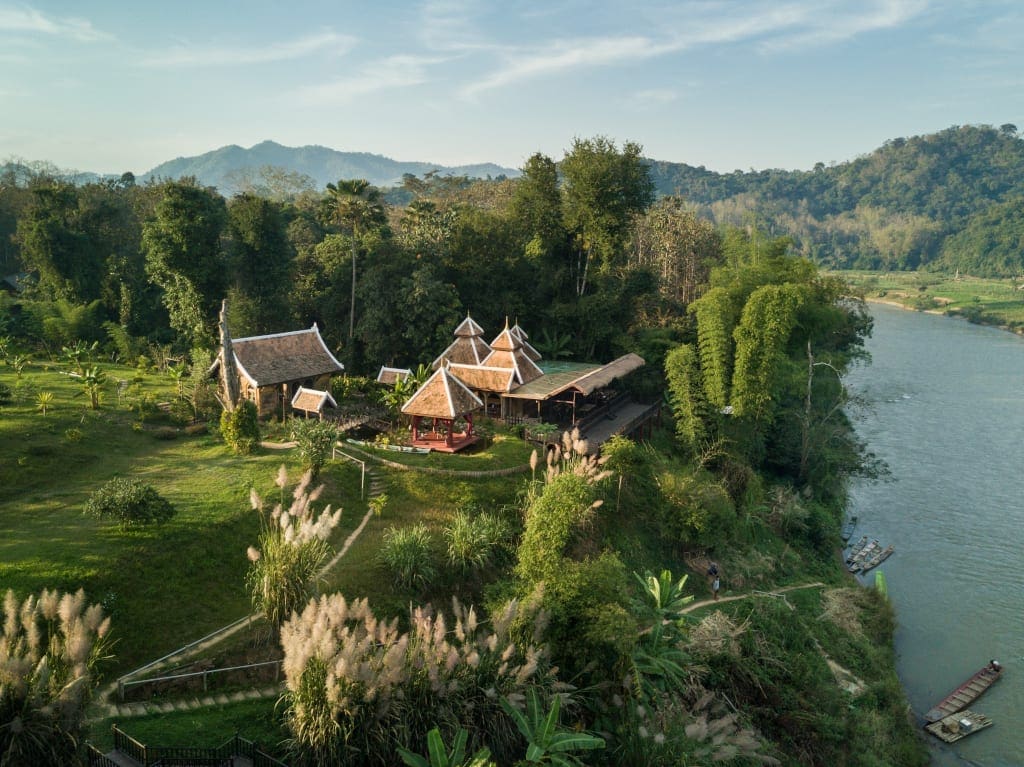
Our visit starts with a talk from our guide Than, who explains the house rules, as well as the Mandalao philosophy. Here people are allowed to touch the elephants, but there is no riding and no bathing with them.
“No riding is nothing,” Than explains, “if the elephants are still hungry and work many hours. No riding is just the start.” Mandalao aims to keep the elephants healthy and happy.
Upon arrival I had spoken with Gregorio Rojas, one of the owners of Mandalao, he had explained how the previous day a group of tourists from China had turned up to the sanctuary and left unhappy when they were told they could not ride the elephants.
“When the elephants came here they were skinny,” says Tan. “Now they are healthy.”
Once known as the Land of a Million Elephants, Laos has only around 1,000 elephants remaining, a number that is diminishing by 40 a year, according to Tan. Hence the need for places such as Mandalao to protect the animals and hopefully in time to reintroduce the elephants to the wild. Half the 1,000 elephants are domesticated and half live in the wild. There they are vulnerable to ivory traders, and baby elephants are stolen – often with the mother shot as she fights for her child. Part of Mandalao’s mission is to protect Nam Poui National Park, where it is estimated 40 to 50 wild elephants live.
The highlight of the walk was observing the different personalities of the two elephants, and seeing them interact – or rather not – in a natural environment
Renting 200 hectares of land on the banks of the Nam Khan river, Mandalao started its conservation project in 2016 and was the first in Laos to adopt a non-riding policy. Buying elephants is expensive, with an adult female costing $30,000 and a baby up to double that. Currently the sanctuary has nine elephants, eight of which are adult females and one is a baby elephant, Kit. The plan is to reintroduce the three-year-old Kit to Nam Poui National Park when he’s older. Mandalao will acquire three more elephants before February, including an eight-month little girl.
Tours at Mandalao are limited to a maximum of eight people, with four tours per day, and the elephants going out two by two.
Walking with Elephants
After our instructions, we took a small boat across the Nam Khan river to the sanctuary where the elephants are kept. There we met our two walking companions, Buan Gen (35) and Mae Man, (40), whom we promptly fed with bananas.
From the offset it was clear the elephants didn’t exactly hit it off. Mae Man was the matriarch and she disapproved of her upstart walking colleague. Throughout she would linger at the back of our small convoy allowing Buan Gen to plough ahead through the forest, where it was really humid. Fortunately, the elephants spent most of the time munching away or scratching various parts of their bodies, so the pace was not exactly exerting, and we were able to take regular stops for water or to wipe away the sweat.
Also, as the mahouts had no sticks or bullhooks, the pace was set by the elephants rather than by us. Fortunately, we were issued with ninja boots to walk in, as the terrain became pretty muddy in parts. The boots were really comfortable, and it felt as though we were floating on the earth.
For me the highlight of the walk was observing the different personalities of the two elephants, and seeing them interact – or rather not – in a natural environment. Also, judging by the size of Mae Man, who had quite a considerable girth on her, the elephants were extremely well fed. Perhaps she should be scheduled for two walks a day?
At the end of the walk we returned to our boat and were taken back to the lodge where our lunch awaited.
Walking with Elephants Mandalao Photo Gallery
Mandalao has ambitious plans, including renting further land and rescuing more elephants from logging camps so that it can run a breeding programme and reintegrate elephants to Nam Poui National Park, adopting a model that has worked successfully elsewhere, such as with orangutans in Sepilok, Malaysia. The organisation currently has officers on patrol in the park to protect elephants from illegal logging and poaching. It also runs the non-profit organisation LEI (Lao Elephant Initiative) for all its conservation efforts.
To further its work Mandalao needs people to sponsor elephants and to increase its tourism revenue.
As for me I am sold on the issue, walking with elephants rather than riding on them is definitely the way forwards. The only problem seems to be persuading Mae Man to walk with other elephants too. But there again we all know how stubborn elephants can be.
For more information about Mandalao
Walking with elephants is one of the programmes that Mandalao offers. Tours can be booked through Tiger Trail Travel. For more information on Mandalao, click here.

